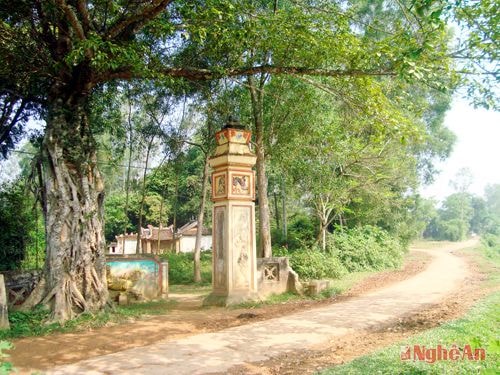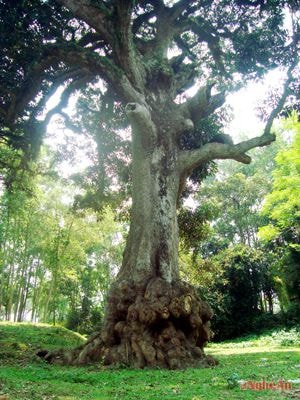Persistence of a village tradition
(Baonghean) - Located on the right bank of the Gang River, the ancient Yen Lac village, Thanh Ngoc commune (Thanh Chuong) with many temples, palaces, and shops, is a red address associated with the revolutionary struggle of our people...
The village was born long ago, in the early 15th century when the ancestors of the Tran and Vo families came here to settle down, the village already existed. To the west, the Gang River meandered between the two banks of corn and rice; to the east, Elephant and White mountains formed a towering strip, protecting and sheltering the village. The old village had two hamlets: Yen Thuong and Yen Ha; after the revolution, many new hamlets were born in the village.
According to the elders, Yen Thuong hamlet has a 3-room communal house made of jackfruit wood, facing south. Next to the communal house, the village erected a stele of Ba Hau - to record the merit of the woman who contributed money to the village, built the palace, and communal house. Behind the communal house is Yen Thuong pagoda, with a three-door gate and a large shrine, inside which are worshiped many Buddha statues. Yen Ha hamlet also has a 3-room communal house made of ironwood, with walls on three sides. Every year, the communal house often holds the opening ceremony and the death anniversary of King Mai Hac De.
In the years 1930 - 1931, Yen Ha communal house was the training place of the Red Guards; the workplace of the local Soviet government; the place where the Provincial Party Committee cadre Nguyen Van Tieu sacrificed his life during a raid and shooting in the village. Next to the communal house is Yen Ha pagoda, hidden under the shade of ancient trees. Today, the two pagodas have faded away; Yen Thuong communal house only has a banyan tree and a merit stele on the old ground, now a kindergarten; Yen Ha communal house, although restored by the villagers, is located in the grounds of a temple.
 |
| Yen Thuong Palace, Thanh Ngoc Commune (Thanh Chuong). |
Along the Gang River, there is Yen Thuong Temple, which worships 8 gods and is located on a beautiful land overlooking the river. The gate of the temple is two pillars facing the village communal house; the upper hall, the left wing, and the right wing are small houses, elaborately carved; on both sides are statues of civil and military mandarins; in front is a three-room jackfruit wood worshiping house, with an altar with two neat rows. Every year, villagers often gather at the temple to pray for peace in the spring and pray for rain during droughts. In the years 1930 - 1931, the temple was a place to hide revolutionary documents and a guard post for the Red Guards. During the anti-American war, the entire temple garden was nearly 2 acres wide with many ancient trees, rattan, and dense bamboo, and was a shelter for convoys of cars transporting goods to the front line... After a long period of degradation and ruin, in 2010, the temple was restored and embellished by the villagers. The ancient banyan tree in front of the yard still casts its luxuriant shade. The banyan tree in front of the gate embraces one side of the pillar. For hundreds of years, Yen Thuong Palace has not only been a place for spiritual and cultural activities of the village, but also a place for many tourists to stop, burn incense, and enjoy the scenery every time they visit the village.
The village also has a Holy Temple located on Ruong Lai field, worshiping Confucius and the sages; it is a place where scholars burn incense, and they often come to pray for success every time they take exams. The villagers say that the Holy Temple was built far from the village communal house, because the ancestors invited a geomancer to choose a beautiful piece of land to build it, hoping that the children in the village would be successful in their studies... In 2010, the Holy Temple was renovated by the villagers, including a shrine and a three-door gate. In the temple grounds, on the left side, a lotus pond was created and a memorial stele was erected to commemorate the village's martyrs.
 |
| Floating tree in Yen Ha. |
Yen Ha wharf has two ancient trees, which are the communal meeting place of the village. The old banyan tree, near the water's edge, casts its shade over the middle of the river wharf. Right next to it is a drift tree hundreds of years old, with a trunk tens of meters high and a base large enough for 7 or 8 people to hug. In the years 1930 - 1931, the drift tree was where revolutionaries planted the red hammer and sickle flag; where villagers gathered in the streets to fight against colonialism and feudalism. At Yen Thuong wharf, during the anti-American war, soldiers built a wooden bridge across the Gang River, allowing trucks to transport goods to the front line, avoiding the "fire bow" of Ru Nguoc and Truong Bon. The Americans once dropped bombs to destroy the bridge, to cut off this important route, but the Yen Thuong bridge still stands tall. The drift tree was also dug a deep hole next to it by American bombs and broke many branches. Now, on its trunk, there are many jagged wounds from storms, bullets and bombs, although they have healed, they are still clearly visible. The old river wharf has a bridge across it, the banyan tree is no longer there, but the driftwood tree still grows green and strong, a testament and symbol of the strong vitality and indomitable fighting spirit of the people here.
The once poor countryside, now no longer has the scene of "Who comes to Yen Lac to see / Bringing pots to the stove and carrying hot pots to the fields", high-rise buildings, concrete roads are becoming more and more numerous, and especially, the traditional cultural values of many generations of ancestors are still preserved by the people here.
Huy Thu
